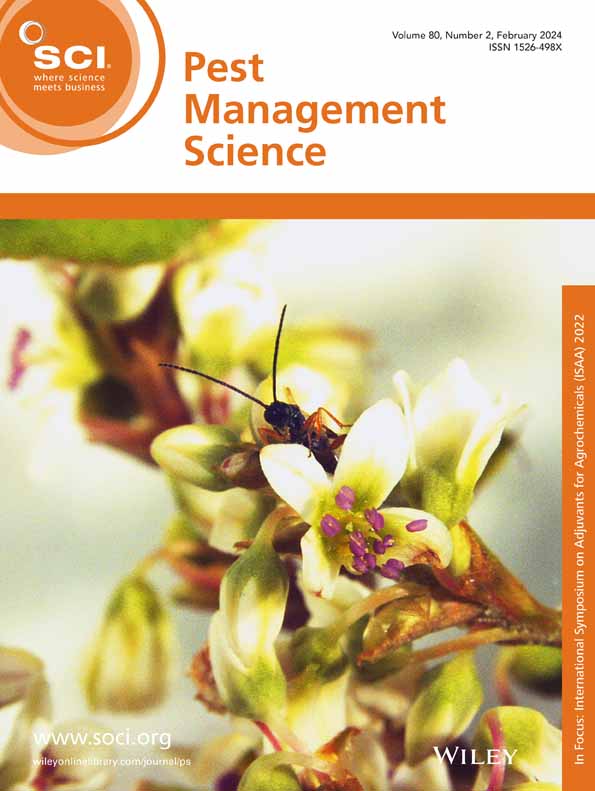Bxy - gold - 1在木参减数分裂和卵母细胞发育中的调控作用
IF 3.8
1区 农林科学
Q1 AGRONOMY
引用次数: 0
摘要
背景研究松材线虫(Bursaphelenchus xylophilus)种系的细胞命运可以揭示其生殖过程的生物学特性,对制定更有针对性的松材线虫病防治策略具有重要意义。然而,在种系中控制木芽孢杆菌细胞命运的分子调控机制尚不清楚。结果本研究通过生物信息学分析、原位杂交和RNA干扰(RNAi)联合DAPI染色技术对嗜木芽孢杆菌Bxy‐gold‐1基因进行了功能验证。生物信息学研究表明,Bxy‐gld‐1基因与模式生物秀丽隐杆线虫中的gld‐1基因高度相似。原位杂交结果表明,Bxy - gold - 1基因在线虫所有发育阶段的性腺区域均有表达。RNAi结果表明,沉默Bxy - gold - 1基因会延迟木嗜线虫生殖系细胞从有丝分裂到减数分裂的转变,并导致雌性线虫卵母细胞发育异常,导致卵母细胞变小。此外,寿命分析显示,RNAi处理组的雌性和雄性线虫的寿命显著降低。结论Bxy - gold - 1基因是木芽孢杆菌生殖系细胞命运的关键调控因子,有助于进一步了解其生殖机制,为开发靶向治疗木芽孢菌提供依据。©2025化学工业协会。本文章由计算机程序翻译,如有差异,请以英文原文为准。
Regulatory role of the Bxy‐gld‐1 in meiosis and oocyte development of Bursaphelenchus xylophilus
BACKGROUNDInvestigating the cell fate of the germline in Bursaphelenchus xylophilus can reveal the biological characteristics of its reproductive processes, which is crucial for formulating more targeted control strategies against pine wilt disease. However, the molecular regulatory mechanisms governing cell fate in the germline of B. xylophilus remain unclear.RESULTSIn this study, we performed functional validation of the Bxy‐gld‐1 gene in B. xylophilus through bioinformatics analysis, in situ hybridization, and RNA interference (RNAi) combined with DAPI staining techniques. Bioinformatics research indicates that the Bxy‐gld‐1 gene is highly similar to the gld‐1 gene in the model organism Caenorhabditis elegans . In situ hybridization results demonstrate that the Bxy‐gld‐1 gene is expressed in the gonadal regions of nematodes at all developmental stages. RNAi results show that silencing the Bxy‐gld‐1 gene delays the transition of germline cells from mitosis to meiosis in B. xylophilus and can cause abnormal oocyte development in female nematodes, leading to the occurrence of small oocytes. Additionally, lifespan assays revealed that the longevity of virgin female and male nematodes in the RNAi‐treated group was significantly reduced.CONCLUSIONSThis study identifies the Bxy‐gld‐1 gene as a key regulator of germline cell fate in B. xylophilus , advancing our understanding of its reproductive mechanisms and providing a basis for targeted therapeutic development. © 2025 Society of Chemical Industry.
求助全文
通过发布文献求助,成功后即可免费获取论文全文。
去求助
来源期刊

Pest Management Science
农林科学-昆虫学
CiteScore
7.90
自引率
9.80%
发文量
553
审稿时长
4.8 months
期刊介绍:
Pest Management Science is the international journal of research and development in crop protection and pest control. Since its launch in 1970, the journal has become the premier forum for papers on the discovery, application, and impact on the environment of products and strategies designed for pest management.
Published for SCI by John Wiley & Sons Ltd.
 求助内容:
求助内容: 应助结果提醒方式:
应助结果提醒方式:


